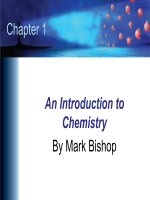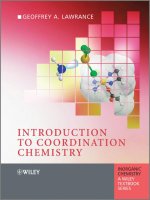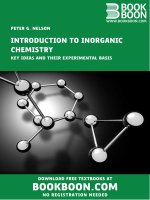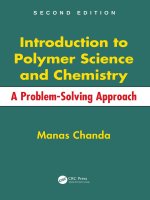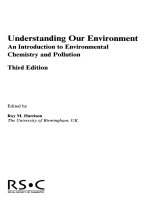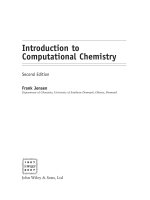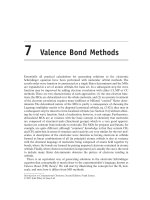Organic chemistry exam helper introduction to organic chemistry
Bạn đang xem bản rút gọn của tài liệu. Xem và tải ngay bản đầy đủ của tài liệu tại đây (2.11 MB, 298 trang )
OrganicChemistryExamHelper
IntroductiontoOrganicChemistry
ByMatthewPasek,Ph.D.
OrganicChemistryExamHelper:IntroductiontoOrganicChemistryby
MatthewPasek
PublishedbyFreeRadicalConsulting
2703PembertonCreekDrive,SeffnerFL33584
©2017MatthewPasek
Allrightsreserved.Noportionofthisbookmaybereproducedinanyform
withoutpermissionfromthepublisher,exceptaspermittedbyU.S.copyright
law.Forpermissionscontact:
Forward
Thisbookispartofaseriesoforganicchemistrystudyguides.Itfocusesonthe
introductorymaterialcoveredbyorganicchemistryclasses:ageneraloverview,
detailsofbonding,molecularformulae,acidsandbases,hybridization,
nomenclature,andconformations.Mostimportanttothestudentoforganic
chemistryarethequizzesattheend.Thesequizzesallowyoutotestyour
knowledgeofkeyconcepts.Withorganicchemistry,practicemakesperfect.
Thefrequentpracticeoforganicchemistryreactionswillhelpyoupass,oreven
ace,anorganicchemistryexam.
Thesubjectscoveredinthisbookaretheintroductorymaterialsoforganic
chemistry.Eachorganicchemistryclassisdifferent:somewillemphasize
specificcharacteristicsnotincludedhere,otherswillbesticklersforcertain
aspectsoforganicchemistry(typicallyifthat’stheprofessor’sareaoffocus)and
maynotusethesamesuiteasthoseshownhere,andstillotherswillfocusona
bareminimumsetofconcepts,dueeithertotimeconstraintsorpedagogical
concerns.Thisguideismeanttosupplement,andnotreplace,attendingthe
organicchemistrycourse.
Iamaprofessorofgeochemistryandnotanorganicchemist.However,the
organicchemistryfundamentalsareanimportantpartofanychemist’straining,
andIlearnedorganicchemistryleftandrightformyownresearchandformy
grants.I’vetutoredmanystudentsinthissubject,butitispossibleforthereto
beerrorsinthesequestionsasIamnotanorganicchemistbyprofession.
FigureshereweredrawnusingACDlab’sChemSketchprogram.Thisprogram
isgreatfordrawingorganicmolecules.Othersketchesaredonebyhandorwith
powerpoint.
TOC
Contents
1.Whatisorganicchemistry?
2.Bondsinorganicchemistry
3.Molecularformula
4.SaturationChemistry
5.Resonance
6.Skeletaldrawings
7.Molecularhybridization
8.AcidsandBases
9.From2Dto3D
10.Isomers
11.Stereoisomers
12.MolecularAttractiveForces
13.HydrogenBonding
14.Nomenclature
15.Nomenclature2
16.Fromdiagramstonomenclature
17.QuizMe!
18.ConclusionandCartoon
1.Whatisorganicchemistry?
Chemistryisthescienceoftheelectron.Organicchemistryisabranchof
chemistry.Organicchemistryisthechemistryoftheelementcarbon,gliblyput.
Nearlyall(butNOTall)carboncompoundsareorganiccompounds.Organic
chemistryaroseoutofasearchforadifferencebetween“alive”and“notalive”.
Suchasearchinvolvedaconceptcalled“vitalism”,thebeliefthattherewas
somethingfundamentallydifferentbetweenthemoleculesoflifeandthosethat
wereformedbynon-life.Well,itturnsoutthereisn’treallyanymajor
difference.Asidefromabitmoreradiocarboninlivingthings(becausethey
activelyexchangecarbonwiththeatmosphere,unlikemostnon-living
reactions),thechemistryoforganiccompoundsmadebylifeorbymanandnonbiologicreactionsisthesame.Fundamentally,thechemistryofnon-living
carboncompoundsisidenticaltolivingcarboncompounds.
Theglibdefinitionof“organicchemistry=carbonchemistry”doesneedsome
caveats,however.Forinstance,manygeologistsstudyarockcalledlimestone.
Limestoneismostlycomposedofamineralcalledcalcite,whichhasaformula
ofCaCO3.Thecarbonincalcite,andincarbonate(CO32-,HCO3-,CO2)in
general,isnotconsideredtobeorganic,sinceitformsbynon-biologic
processes.
Similarly,severalothersimplecompoundsarenotconsideredtobeorganic.
Theseincludehydrogencyanide(HCN),whichformsseveralinorganicsalts,
anddiamondandgraphite,whicharebothcarbonminerals,andsiliconcarbide
(SiC)andironcarbide,whichareminerals.
Amoreexhaustivedefinitionoforganicisthatthecarbonatomsofthemolecule
shouldbecovalentlyboundtoeitherhydrogenorcarbon(andpreferentially
hydrogenatsomepointinthestructure).Carbonthatformsionicbondsand
metallicbondsistypicallynotconsideredorganic.Similarly,graphiteand
diamondareessentiallypurecarbon,andaren’tconsideredorganic.
Naturallythere’safairbitoffuzzinesswithdeterminingwhetheracarboncontainingcompoundisorganicornot.Somedon’tfeelthatformaldehydeisan
organiccompound,whereastoothersitobviouslyis.ThesameistrueforHCN,
whichweidentifiedasinorganic.Somescientistsargueitisbetterdescribedas
organic.Intheend,mostofthecasesattheintersectionareintuitive.Aslongas
there’smorethanonecarbon,andit’sboundtoanothercarbonorhydrogen,you
cangenerallyassumethecompoundtobeorganic.
Notethatorganichasnothingtodowith“comingfromnature”,sothere’savast
differencebetweenorganicchemistryandtheorganicfoodthatyoumightbuyat
WholeFoodsorTraderJoe’s.Organicinchemistryprovidesnorealdiscerning
valueastoitsorigin,oritsinherent“health”.
KEYPOINTSANDHINTS:
Organicchemistryisthechemistryofcarbon,butnotallcarbon-bearing
moleculesareorganic.
Organiccarboncompoundsshouldhavecovalentbonds,andshouldhaveC-Cor
C-Hbonds.
2.Bondsinorganicchemistry
Bondingdiagramsinchemistryshowhowtheelectronsaredistributedin
compounds.Theelementcarbonhasanelectronicstructureof1s22s22p2
(rememberthatfromGenChem?).Thismeansthatcarbonhasfourvalence
electronsinthesecondshell.Itiscapableofformingfourbondswiththese
valenceelectrons.Althoughfivebondsdooccurasintermediatesortransition
states,thesearenotstable.Drawingastructurewithfivebondstocarbonhas
beengivenacolloquialnameof“TexasCarbon”(everything’sbiggerin
Texas!).Ifyoudrawamoleculewithfivebondstocarbon(includingdouble
bonds),you’veprobablydrawnitwrong.Becareful!
AcommonwayofrepresentingbondinginmoleculesisthroughaLewisdot
structure.LewisdotstructureswerefirstusedbyachemistGilbertLewis,who
designedthesediagramstoshowhowelectronsweresharedornot(notinvolved
inabond)betweendifferentatomsinabondormolecule.
Youcancalculatea“formalcharge”ofamoleculeby:
FC=NV–NU–BE/2
WhereFCistheformalcharge,NVisthenumberofvalenceelectrons(4for
carbon,5forN,6forO,etc.),NUisthenumberofunbondedelectrons,andBEis
thenumberofelectronsparticipatinginbonds.
TheLewisdotstructuremustbydefinitionshowallelectrons.Itisofteneasier
tosimplifysomeofthisbydrawingbondingelectronsasaline,insteadofdots.
Twolinesshowthere’sadoublebond,andthreeshowthere’satriplebond.
Electronsthatdon’tparticipateinbondsarestillshownexplicitlyinaLewisdot
structure.
KEYPOINTSANDHINTS:
Lewisdotstructuresshowbondsandunbondedelectrons.
Ifastructurehas5bondstocarbon,itisverylikelywrong!
Carbonalmostneverhasafreeelectronpaironit(exceptforcarbenes)
PracticeSections1&2?
Problem1
Problem2
Problem3
Problem4
Problem5
BacktoTOC
Problem1.
Identifywhichoftheseisanorganiccompound
A)CaCO3B)C60(AKAabuckyball)
C)N2D)H3C-CH3
Gobacktosection
YES!
Nextproblem?
Gobacktosection
No.
Gobacktoproblem
Gobacktosection
Problem2.
WhatistheLewisdotstructureforformaldehyde,H2CO?
A)
B)
C)
Gobacktosection
D)
YES!
Nextproblem?
Gobacktosection
No.
Gobacktoproblem
Gobacktosection
Problem3.
WhatisthecorrectbondingstructureforC2N2,AKAcyanogen?
A)
B)
C)
D)
Gobacktosection
YES!
Nextproblem?
Gobacktosection
No.
Gobacktoproblem
Gobacktosection
Problem4.
Providethecorrectstructureofpropane,C3H8.
A)
B)
C)
Gobacktosection
D)
YES!
Nextproblem?
Gobacktosection
No.
WatchoutforTexasCarbons!
Gobacktoproblem
Gobacktosection
Problem5.
WhatistheformalchargeofNinN2?
A)+5B)-3
C)0D)+3
Gobacktosection
YES!
Gobacktoproblem
Gobacktosection
BacktoTOC
No.
Gobacktoproblem
Gobacktosection
3.Molecularformula
Amolecularformulaisaquickwayofdescribingamolecule.Ittellsyou
specificallywhatelementsareinagivencompound.Itdiffersfromanempirical
formula,whichonlygivesasimplifiedversionofaformula.Empiricalformulas
arealmostneverusedinorganicchemistry,becausetoomuchinformationislost
whensimplifyingamolecularformuladowntoanempiricalformula.Asan
example,ethaneisC2H6.TheempiricalformulaforethaneisCH3.Toan
organicchemist,thelatterisvirtuallyuseless.
Themolecularformulacanalsobereorganizedintoasimplestructuralformula.
Intheaboveexampleofethane,theformulaofC2H6canberewrittenasH3CCH3
orCH3CH3.BothformulaenowgivethereaderabitofinsightastohowtheC
andHarebonded,betterthanC2H6.
Structuralformulaetakelongertowritethanmolecularformulae,butingeneral
theyarebetterastheyprovidemoreinformation.However,attimesamolecular
formulawillbetheonlyonethatwillwork.Considercyclohexane(C6H12):

